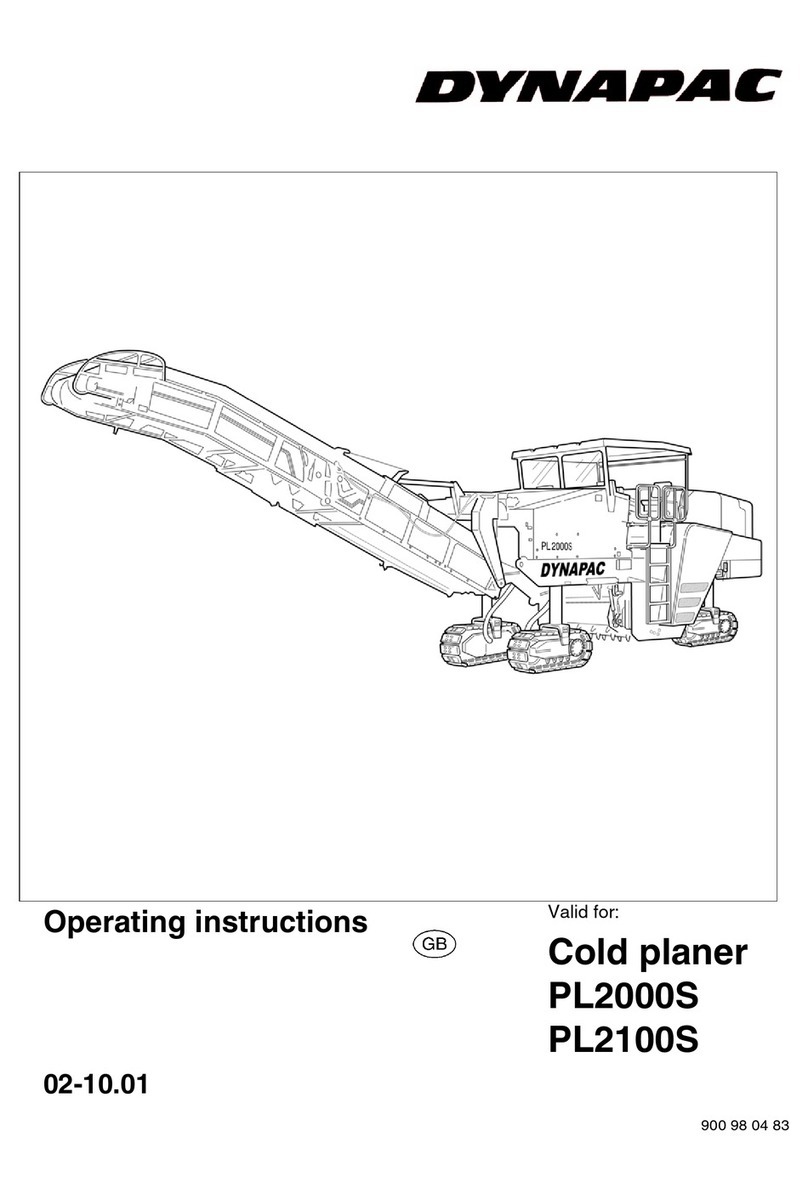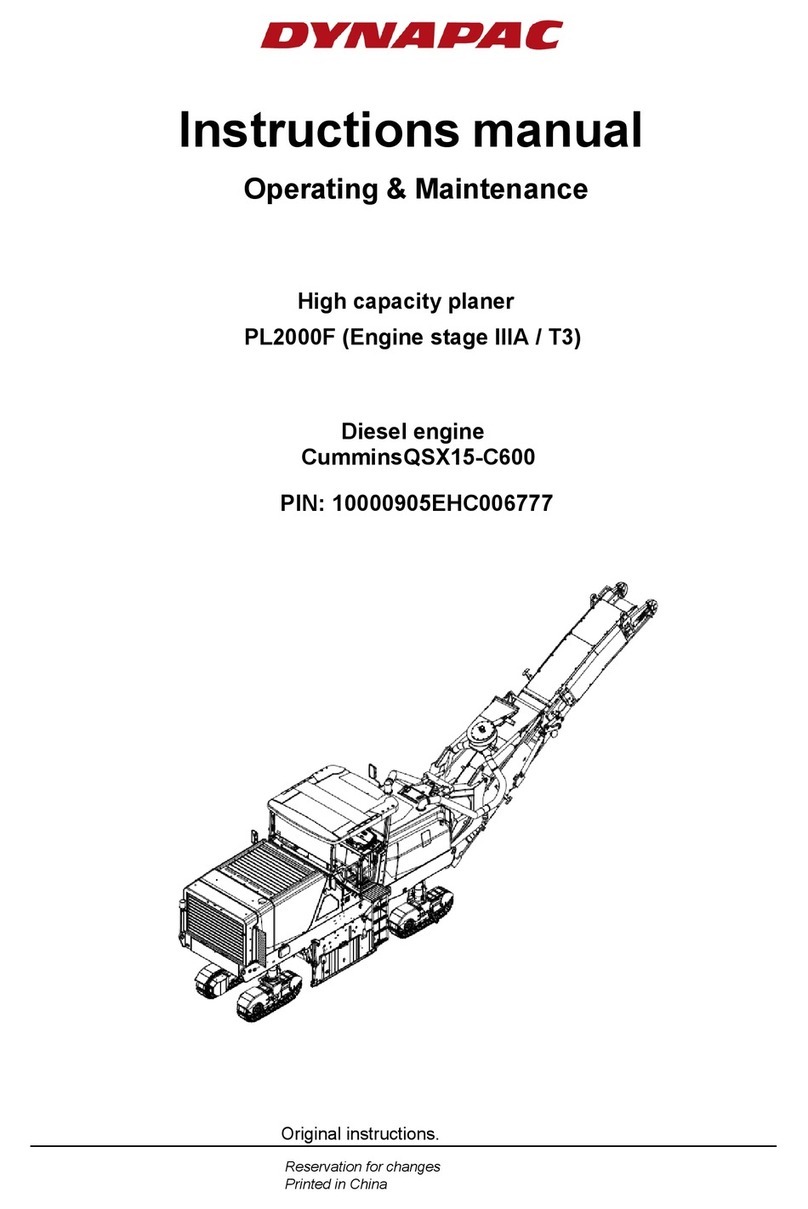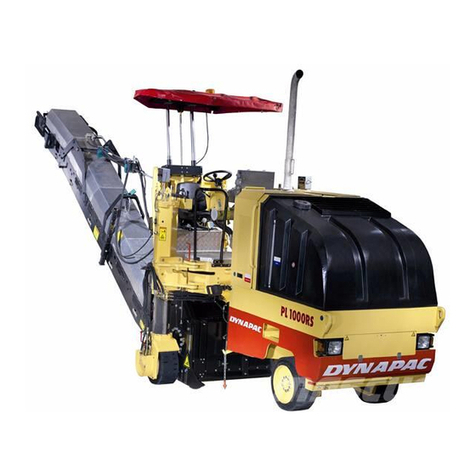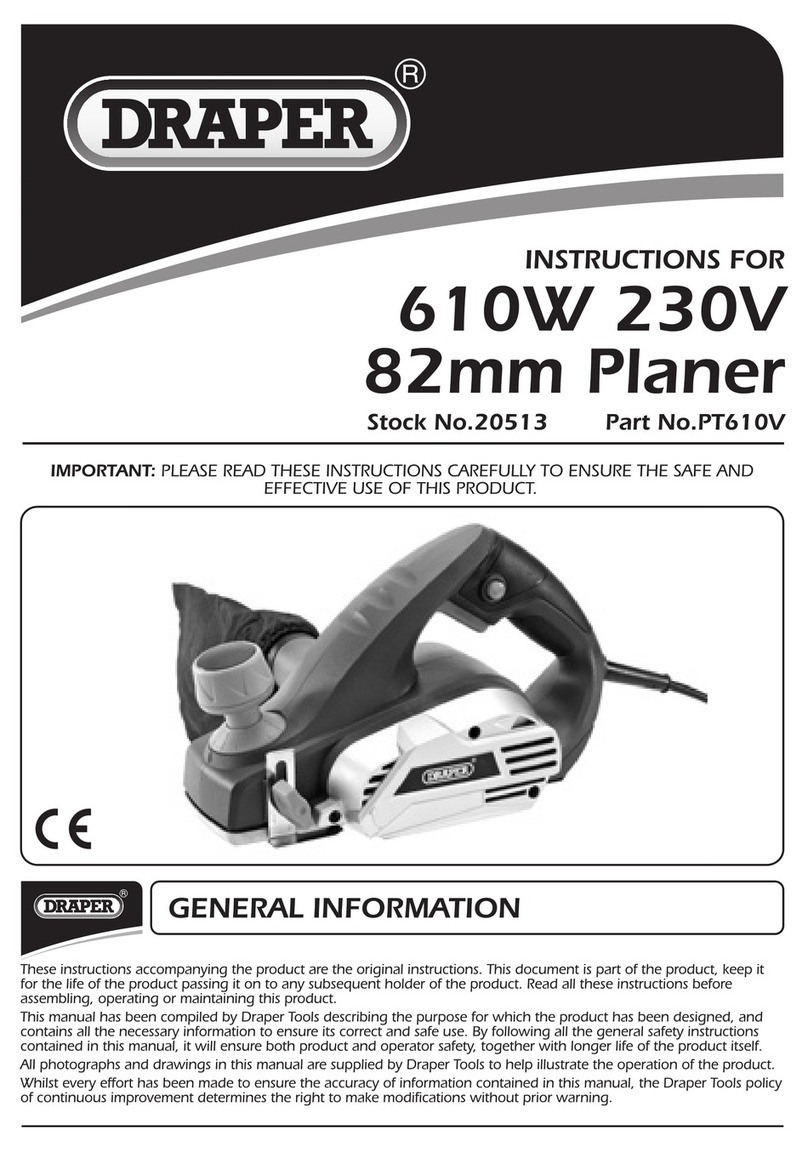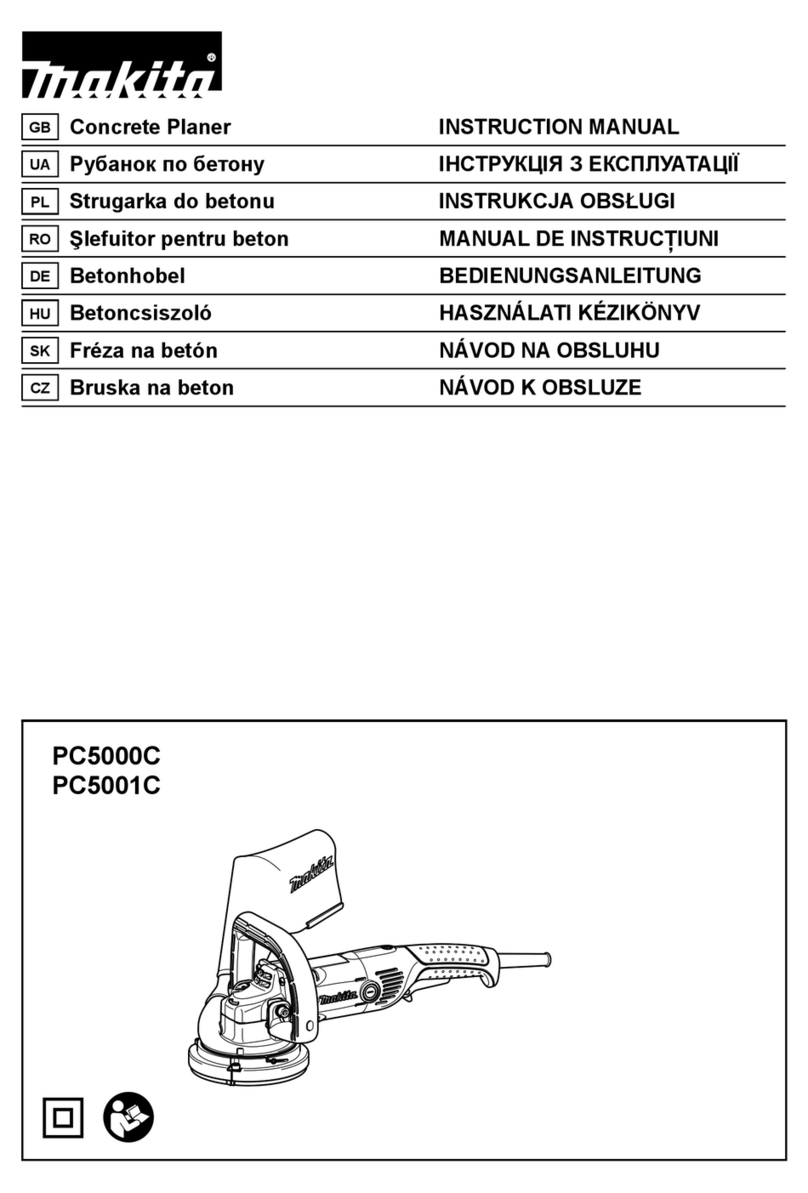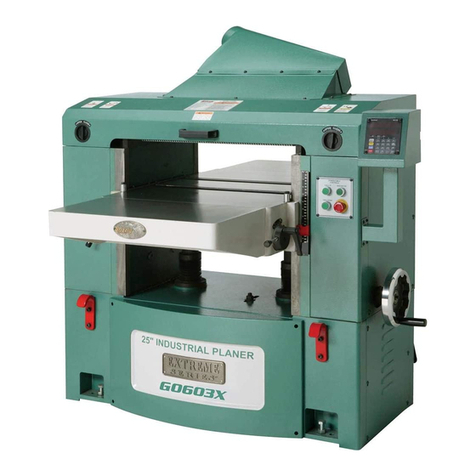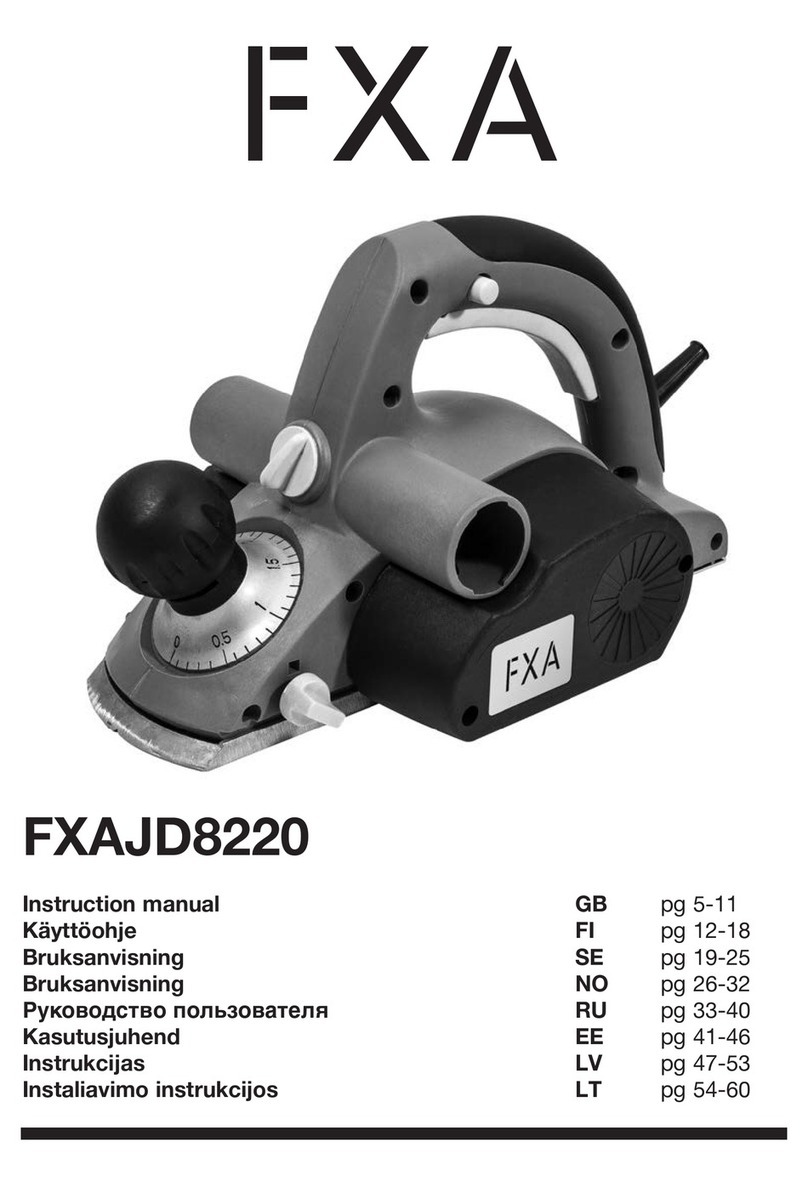Dynapac PL350 TD User manual

Instructions manualInstructions manual
IPL350TD-1EN2.pdfIPL350TD-1EN2.pdf
Operating & MaintenanceOperating & Maintenance
PlanerPlaner
PL350 TDPL350 TD
Diesel engineDiesel engine
Cummins B3.3Cummins B3.3
Serial numberSerial number
10000900x0A006571 - 10000900x0A006571 -
Translation of original instructions.Translation of original instructions.
Reservation for changesReservation for changes
Printed in SwedenPrinted in Sweden


2000h-Maintenance
IPL350TD-1EN2.pdf2012-06-18
Table of Contents
Introduction .............................................................................................................................. 1
The machine ............................................................................................... 1
Intended use ............................................................................................... 1
Warning symbols......................................................................................... 2
General ....................................................................................................... 2
Safety - General instructions.................................................................................................... 3
Safety - when operating ........................................................................................................... 5
Risk zones on the machine ......................................................................... 5
Slopes ......................................................................................................... 6
Safety (Optional) ...................................................................................................................... 7
Conveyor (option)........................................................................................ 7
Special instructions .................................................................................................................. 9
Standard lubricants and other recommended oils and fluids ...................... 9
Higher ambient temperatures, above +40°C (104°F).................................. 9
Lower ambient temperature - Freeze risk ................................................... 9
Temperatures.............................................................................................. 9
High pressure cleaning ............................................................................. 10
Fire fighting ............................................................................................... 10
Battery handling ........................................................................................ 10
Jump starting (24V)................................................................................... 11
Technical specifications ......................................................................................................... 13
Vibrations - Operator station ..................................................................... 13
Noise level................................................................................................. 13
Dimensions, side view............................................................................... 14
Dimensions, top view ................................................................................ 15
Weights and volumes................................................................................ 16
Working capacity....................................................................................... 16
General ..................................................................................................... 17
Tightening torque ...................................................................................... 18
Machine description ............................................................................................................... 19

2000h-Maintenance
IPL350TD-1EN2.pdf 2012-06-18
Identification ............................................................................................................ 19
Explanation of 17PIN serial number.......................................................... 19
Product identification number on the frame .............................................. 19
Machine plate............................................................................................ 20
Decals...................................................................................................................... 21
Positioning of labels, right-hand side ........................................................ 21
Positioning of labels, left-hand side........................................................... 21
Safety decals............................................................................................. 23
Info decals................................................................................................. 24
Instruments/Controls ............................................................................................... 25
Control panel and controls ........................................................................ 25
Functional description of control panel...................................................... 26
Electrical system...................................................................................................... 28
Main fuses................................................................................................. 28
Fuses, machine......................................................................................... 29
Relays, machine........................................................................................ 29
Functional description.............................................................................................. 30
Front plate ................................................................................................. 30
Footplate extension (option)...................................................................... 30
Driver´s seat (option)................................................................................. 31
Conveyor belt (option)............................................................................... 31
Rear door .................................................................................................. 32
Safety switch ............................................................................................. 33
Working lights............................................................................................ 34
Vandalism protection................................................................................. 35
Stop valve, milling drum freewheel ........................................................... 35
Bits - Tool holder ....................................................................................... 35
Typical wear marks on tool holder ............................................................ 36
Typical wear marks on bits........................................................................ 36
Bits - Checking - Fitting/Removing........................................................... 37

2000h-Maintenance
IPL350TD-1EN2.pdf2012-06-18
Tool holder - Checking/Replacing ............................................................. 38
Operation ............................................................................................................................... 39
Before starting ......................................................................................................... 39
Safety switch - Operation .......................................................................... 39
Steering wheel - Adjustment ..................................................................... 39
View .......................................................................................................... 40
Driver seat - Adjustment (option) .............................................................. 40
Unlock the vandalism protection ............................................................... 40
Master switch - Switching on..................................................................... 41
Starting .................................................................................................................... 42
Starting the engine .................................................................................... 42
Operation................................................................................................................. 43
Positioning................................................................................................. 43
Driving the machine .................................................................................. 43
Driving on difficult surfaces ....................................................................... 44
Drive wheels.............................................................................................. 44
Swivel chassis leg. .................................................................................... 45
Direction of steering indicator.................................................................... 45
Pointer....................................................................................................... 45
Milling/Levelling ....................................................................................................... 46
Milling depth indicator, adjustment............................................................ 46
Milling depth indicator Position stop.......................................................... 47
Flow valve ................................................................................................. 47
Ballast rear - Adjusting machine weight .................................................... 48
Ballast front - Adjusting machine weight ................................................... 48
Milling instructions..................................................................................... 49
Milling position........................................................................................... 49
Resetting milling depth.............................................................................. 49
Surface milling........................................................................................... 50
Milling at edge of roadway or at shoulders................................................ 50

2000h-Maintenance
IPL350TD-1EN2.pdf 2012-06-18
Milling at curb edge with folded out chassis leg. ....................................... 51
Milling at curb edge with folded in chassis leg. ......................................... 51
Milling preparations ................................................................................... 52
Milling ........................................................................................................ 53
Stop milling................................................................................................ 53
Braking .................................................................................................................... 54
Normal braking.......................................................................................... 54
Parking brake ............................................................................................ 54
Reserve brake........................................................................................... 54
Emergency braking ................................................................................... 55
Parking .................................................................................................................... 55
Parking/Switching off................................................................................. 55
Master switch ............................................................................................ 55
Cleaning the machine ............................................................................... 56
Long-term parking.................................................................................................................. 57
Battery....................................................................................................... 57
Engine ....................................................................................................... 57
Watering system ....................................................................................... 57
Hoods, tarpaulin ........................................................................................ 57
Miscellaneous ........................................................................................................................ 59
Lifting ....................................................................................................................... 59
Lifting the planer........................................................................................ 59
Towing/Recovery..................................................................................................... 60
Releasing the brakes ................................................................................ 60
Towing the planer...................................................................................... 61
Transport ................................................................................................................. 61
Machine prepared for transport................................................................. 61
Preventive maintenance ........................................................................................................ 63
Acceptance and delivery inspection.......................................................... 63
Warranty.................................................................................................... 63

2000h-Maintenance
IPL350TD-1EN2.pdf2012-06-18
Maintenance - Lubricants and symbols ................................................................................. 65
Maintenance - Maintenance schedule ................................................................................... 67
Service and maintenance points ............................................................... 67
General ..................................................................................................... 67
Every 10 hours of operation (Daily)........................................................... 68
Every 50 hours of operation (Weekly)....................................................... 69
After the FIRST 250 hours of operation. ................................................... 69
Every 250 hours of operation (Monthly) .................................................... 69
Every 500 hours of operation (Every three months) ................................. 70
Every 1000 hours of operation (Every six months) ................................... 70
Every 2000 hours of operation (Yearly) .................................................... 70
Maintenance, 10h .................................................................................................................. 71
Diesel engine - Check oil level/Filling........................................................ 71
Hydraulic reservoir - Check fluid level....................................................... 72
Fuel tank - Filling....................................................................................... 72
Check the high-pressure hydraulic filter.................................................... 73
Check return filter - suction side................................................................ 73
Water tank - filling ..................................................................................... 74
Sprinkler system/nozzles
Checking/Cleaning .................................................................................... 74
Water filter - Checking/Replacing.............................................................. 75
Clean cooler .............................................................................................. 75
Check level, radiator ................................................................................. 76
Brake function/Emergency stop - Check................................................... 76
Check safety switches............................................................................... 77
Diesel engine - Checking the drive belt..................................................... 78
Maintenance - 50h ................................................................................................................. 79
Air cleaner - emptying ............................................................................... 79
Drive wheel, Planetary gear - Check of oil level........................................ 79
Check rubber seal - Milling housing .......................................................... 80

2000h-Maintenance
IPL350TD-1EN2.pdf 2012-06-18
Crown wheel - Front wheel ....................................................................... 81
Side plates - Check ................................................................................... 81
Side plates - Replacement ........................................................................ 82
Maintenance - 250h ............................................................................................................... 83
Battery
Checking the electrolyte level ................................................................... 83
Slide rails - Check ..................................................................................... 84
Milling depth, limit position ........................................................................ 85
Diesel engine - Oil change - Filter replacement ........................................ 85
Check - Replace air cleaner's filter element.............................................. 86
Air cleaner
- Cleaning.................................................................................................. 87
Maintenance - 500h ............................................................................................................... 89
Fuel filter - Replacement ........................................................................... 89
Fuel filter - Bleeding the filter .................................................................... 90
Hydraulic reservoir cap - Check ................................................................ 91
Hydraulic hoses
Check ........................................................................................................ 91
Water tank - Emptying / Cleaning ............................................................. 92
Maintenance - 2000h ............................................................................................................. 93
Fuel tank - Drainage.................................................................................. 93
Hydraulic reservoir
Fluid change.............................................................................................. 94
Return oil filter suction side
Replacement ............................................................................................. 95
Drive wheel - Planetary gear, oil draining ................................................. 96
High-pressure hydraulic filter - Replacement ............................................ 96
Milling drum - Removal ............................................................................. 97

Introduction
IPL350TD-1EN2.pdf2012-06-18
Introduction
The machine
Dynapac's PL 350 TD planer is a compact, easy to
operate three-wheeled planer with optional all-wheel
drive.
The machine has hydrostatic drives, variably
adjustable in 2 speed ranges and hydraulic steering
(Orbitrol)
The machine has a maximum milling depth of 100 mm.
The right chassis leg can be folded in for precision
milling along curbes etc.
The very tight turning radius makes it possible, for
example, to mill around man holes.
Extra weights (ballast) can, if necessary, be removed
from the machine to provide additional stability when
milling on various surfaces.
Intended use
PL 350 TD is mainly intended to be used for
roadworks:
• to remove layers of asphalt, asphalt concrete and
concrete.
• remove superficial irregularities in the form of ruts, lateral
unevenness and distortions
• to restore the correct surface profile
• roughen up and remove markings
• to carry out preparations in conjunction with laying piping
and conduits
The above work requires the underlying surface to be
sufficiently stable and strong to withstand the
movement of the planer.
The machine is not designed to be used as a towing
machine, a winch or lifting device. See "Safety Manual
for Planing".
The machine is not intended for using in explosive
atmosphere.
1

Introduction
IPL350TD-1EN2.pdf 2012-06-18
Warning symbols
WARNING ! Marks a danger or a hazardous
procedure that can result in life threatening or
serious injury if the warning is ignored.
WARNING ! Marks a danger or a hazardous
procedure that can result in life threatening or
serious injury if the warning is ignored.
CAUTION ! Marks a danger or hazardous
procedure that can result in damage to the
machine or property if the warning is ignored.
CAUTION ! Marks a danger or hazardous
procedure that can result in damage to the
machine or property if the warning is ignored.
General
This manual contains instructions for machine
operation and maintenance.
The machine must be correctly maintained for
maximal performance.
The machine should be kept clean so that any
leakages, loose bolts and loose connections are
discovered at as early a point in time as possible.
Inspect the machine every day, before starting.
Inspect the entire machine so that any leakages or
other faults are detected.
Check the ground under the machine. Leakages are
more easily detected on the ground than on the
machine itself.
THINK ENVIRONMENT ! Do not release oil,
fuel and other environmentally hazardous
substances into the environment. Always send
used filters, drain oil and fuel remnants to
environmentally correct disposal.
THINK ENVIRONMENT ! Do not release oil,
fuel and other environmentally hazardous
substances into the environment. Always send
used filters, drain oil and fuel remnants to
environmentally correct disposal.
This manual contains instructions for periodic
maintenance normally carried out by the operator.
Additional instructions for the engine can be
found in the manufactuer's engine manual.
Additional instructions for the engine can be
found in the manufactuer's engine manual.
2
Table of contents
Other Dynapac Planer manuals
Popular Planer manuals by other brands

Felisatti
Felisatti PF180/1500 operating instructions

DeWalt
DeWalt DW 1150 Operation, adjustmants, maintenance, spare parts

Triton
Triton TRP UL Operating and safety instructions

Melbourne
Melbourne MTC-49407 owner's manual

VARO
VARO POWERplus POW1520 manual

Powermatic
Powermatic 209 Operating instructions and parts manual
